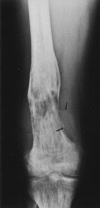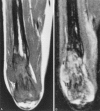Inheritance of osteosarcoma and Paget's disease of bone: a familial loss of heterozygosity study
- PMID: 11687601
- PMCID: PMC1906967
- DOI: 10.1016/S1525-1578(10)60669-1
Inheritance of osteosarcoma and Paget's disease of bone: a familial loss of heterozygosity study
Abstract
Pagetoid osteosarcoma is a complication of Paget's disease of bone. Sarcomatous transformation is most often seen in severe, long-standing Paget's disease. Familial clustering of Paget's disease has been described with apparent autosomal dominant inheritance with high penetrance by the sixth decade. Although definitive proof of the specific gene involved remains elusive, some researchers have shown loss of heterozygosity in a region of chromosome 18q in a relatively high percentage of studied patients affected with either Paget's disease alone, in Pagetoid osteosarcoma, and in uncomplicated osteosarcoma. Our patient was diagnosed with Pagetoid osteosarcoma and had a first-degree relative with history of the same. We hypothesized that our patient's tumor samples might contain a similar genetic abnormality. Our analysis of several polymorphic markers from the chromosome 18q21-22 region showed loss of maternally inherited alleles throughout the region. This finding is similar to those described previously and provides further evidence of a susceptibility region relating to this disease. This report describes a father and son, their young ages at diagnosis of Pagetoid sarcoma, the identical sites of disease involvement, and a loss of heterozygosity study illustrating the inheritance of the presumed defective gene.
Figures






Similar articles
-
Paget's disease of bone: evidence for a susceptibility locus on chromosome 18q and for genetic heterogeneity.J Bone Miner Res. 1998 Jun;13(6):911-7. doi: 10.1359/jbmr.1998.13.6.911. J Bone Miner Res. 1998. PMID: 9626621
-
Familial Paget's disease of bone: nonlinkage to the PDB1 and PDB2 loci on chromosomes 6p and 18q in a large pedigree.J Bone Miner Res. 2001 Jan;16(1):33-8. doi: 10.1359/jbmr.2001.16.1.33. J Bone Miner Res. 2001. PMID: 11149487
-
Common mechanisms of osteosarcoma and Paget's disease.J Bone Miner Res. 1999 Oct;14 Suppl 2:39-44. doi: 10.1002/jbmr.5650140209. J Bone Miner Res. 1999. PMID: 10510212 Review.
-
Mutation screening of the TNFRSF11A gene encoding receptor activator of NF kappa B (RANK) in familial and sporadic Paget's disease of bone and osteosarcoma.Calcif Tissue Int. 2001 Mar;68(3):151-5. doi: 10.1007/s002230001211. Calcif Tissue Int. 2001. PMID: 11351498
-
Osteosarcoma in Paget's disease of bone.J Bone Miner Res. 2006 Dec;21 Suppl 2:P58-63. doi: 10.1359/jbmr.06s211. J Bone Miner Res. 2006. PMID: 17229010 Review.
Cited by
-
Osteosarcoma mechanobiology and therapeutic targets.Br J Pharmacol. 2022 Jan;179(2):201-217. doi: 10.1111/bph.15713. Epub 2021 Dec 21. Br J Pharmacol. 2022. PMID: 34679192 Free PMC article. Review.
-
Defective osteogenic differentiation in the development of osteosarcoma.Sarcoma. 2011;2011:325238. doi: 10.1155/2011/325238. Epub 2011 Feb 22. Sarcoma. 2011. PMID: 21437219 Free PMC article.
-
Segregation of a M404V mutation of the p62/sequestosome 1 (p62/SQSTM1) gene with polyostotic Paget's disease of bone in an Italian family.Arthritis Res Ther. 2005;7(6):R1289-95. doi: 10.1186/ar1828. Epub 2005 Sep 15. Arthritis Res Ther. 2005. PMID: 16277682 Free PMC article.
-
Novel pyroptosis-associated genes signature for predicting the prognosis of sarcoma and validation.Biosci Rep. 2022 Dec 22;42(12):BSR20221053. doi: 10.1042/BSR20221053. Biosci Rep. 2022. PMID: 36155774 Free PMC article.
-
Risk Factors for Development of Canine and Human Osteosarcoma: A Comparative Review.Vet Sci. 2019 May 25;6(2):48. doi: 10.3390/vetsci6020048. Vet Sci. 2019. PMID: 31130627 Free PMC article. Review.
References
-
- Barry HC: Paget’s Disease of Bone. London, E & S Livingstone, Ltd., 1969
-
- Huvos AG, Butler A, Bretsky SS: Osteogenic sarcoma associated with Paget’s disease of bone: a clinicopathologic study of 65 patients. Cancer 1983, 52:1489-1495 - PubMed
-
- Siris ES, Ottman R, Flaster E, Kelsey JL: Familial aggregation of Paget’s disease of bone. J Bone Miner Res 1991, 6:495-500 - PubMed
-
- Haslam SI, Van Hul W, Morales-Piga A, Balemans W, San-Millan JL, Nakatsuka K, Willems P, Haites NE, Ralston SH: Paget’s disease of bone: evidence for a susceptibility locus on chromosome 18q and for genetic heterogeneity. J Bone Miner Res 1998, 13:911-917 - PubMed
Publication types
MeSH terms
LinkOut - more resources
Full Text Sources
Medical

